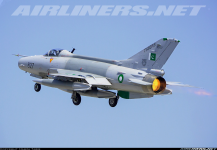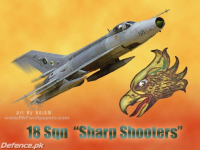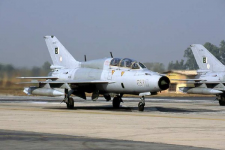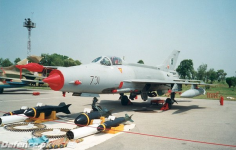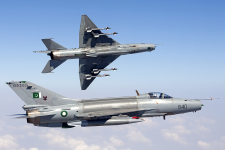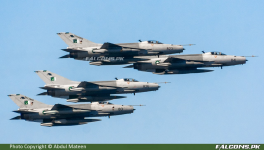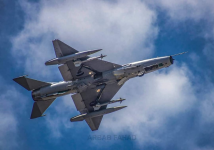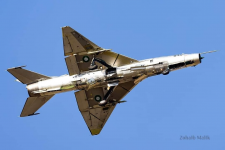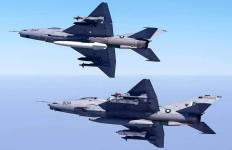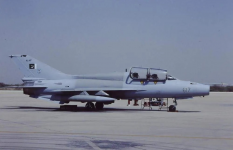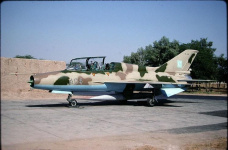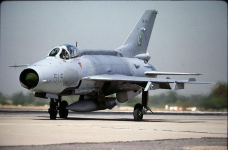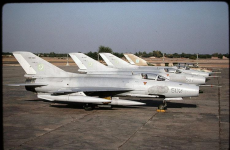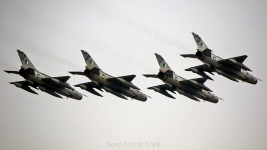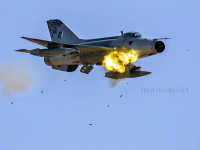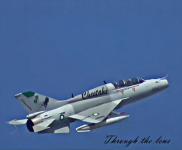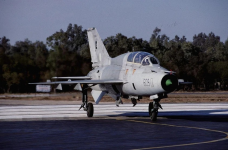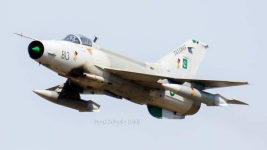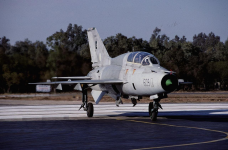Service with PAF:
Pakistani interest in the Mig-21 dates back to the 1970s, and was encouraged by the experiences of a number of later senior PAF pilots who flew the plane while on exchange duties with various Arab air forces. One of these pilots, Flight Leiutenant Sattar Alvi, had shot down an Israeli Mirage III with a K-13 air-to-air missile while flying a Syrian Mig-21 in 1971, thus gaining a very favorable impression of the plane.
Pakistani experiences fighting the Indian Air Force Mig-21s during the 1971 war must also have been very influential since these fighters performed very well in that conflict. As long ago as 1985 Pakistan showed interest in the Chinese version of the Soviet MiG-21PF named F-7 Airguard.
The F-7M was first evaluated by the PAF in early 1987. The evaluation included both air-to-air and air-to-grond performance. Two aircraft were ferried to Pakistan for the evaluation and trials were conducted at Peshawar and Masroor.
PAF's F-7P 'Skybolt' is a varient of the F-7M 'Airgaurd', which was improved for export to customers familiar with Western aircraft. The two-piece canopy of the F-7M and F-7P has greater bird strike resistance and comes with GEC Avioncs HUD and weapons aiming computer plus other new avioncs.
The F-7P incorporated 24 modifications to meet Pakistani requirements, but differs little in external appearance. The first two batches of F-7s were fitted with the Chengdu designed Type IV ejection seats, which has an operating envelope from 70-460 kt. The Type IV has good automatic seperation uses a drogue gun for faster parachute deployment, and can be used at ground level at speeds in excess of 75 kt.
The FT-7 seat is slightly improved, with nine pins that need to be removed before flight, instead of 11 on the original F-7M seat. The Chinese ejection seat is to be replaced by a Martin-Baker Mk 10L. All four underwing weapons pylons are wired for the carriage of air-to-air missiles, including the R.550 Magic and AIM-9 Sidewinder. Twenty were delivered before production switched to the further improved F-7MP, 60 of which were delivered. In Pakistani service the F-7MP retains the simple F-7P designation but can be recognised by pairs of tiny forward and rear hemisphere RWR (Radar Warning Reciever) antennas on each side of the fin tip.
The F-7P's 13,450-lb thrust, WP-7BM engine gives it a thrust-to-weight ratio similar to that of the heavier Mig-21 Bis, but its lighter airframe provides a wing loading claimed to be even lower than the F-16's. This makes the F-7P an excellent fighter in an environment where the IAF's front line inventory includes more than three hundred Mig-21s.
PAF took delivery of the first batch of 20 F-7Ps and 4 FT-7 two-seat trainers in November 1988 to begin re-equipment of No. 20 Squadron at PAF Rafiqui. A long-time Mirage III operator, No. 20 converted to the F-6 in 1986 to familiarise pilots and groundcrew with Soviet bloc equipment. The unit's new F-7s began arriving in the country by July 1988, being ferried to Rafiqui via the Chinese air force base at Hotain. For the ferry flight across the Karakoram mountains they carried 720-litre fuel tanks under the wings as well as the under the center-line.
The 20th Squadron, in reforming on the F-7P at Rafiqui, took on the role of operational conversion unit for the type, which was intended to be a partial replacement for the aging Chinese F-6 aircraft. Shortly before No. 20 Squadron was activated, on 5 November 1989, then Air Chief Marshal Hakimullah spent several days at Rafiqui converting to the new type. The 'Skybolt' name was quickly dropped, and was overpainted on the noses of Pakistan's first batch of aircraft soon after delivery. The second unit to stand up on the F-7P was the 18th Squadron (also at Rafiqui). This began conversion in 1989 with the follow-on order for 60 F-7MPs in 1988-89 and 15 FT-7Ps in 1990-92, and finally 40 F-7Ps in 1993, bringing the total order to 135.
Provisional plans to re-equip No. 15 Squadron at Kamra as the third F-7 squadron were abandoned, and instead the new aircraft went to the No. 2 (Composite) Squadron at Masroor in 1990, previously a second-line unit. The fourth unit to take on the F-7s in its inventory was the No. 19 Squadron at Mianwali during 1991. It was renumbered No. 25 Squadron during mid-1991 when it took over OCU role for the F-7 from No. 20 Squadron after recieving its complement of 9 FT-7Ps (No. 25 Sqd later moved to Minhas during 1996 to take charge of Mirage IIIOs). The remaining aircraft went to the No. 18 Squadron at Rafiqui. At the end of 1998, the squadron moved to Mianwali and took on the OCU role for the F-7. During 1993, F-7 also replaced the increasing obsolete F-6s with the CCS.
The last batch of 40 F-7Ps was inducted in the PAF in 1993. This resulted in formation of two more squadrons and a second-line squadron with the CCS at Sargodha replacing the obsolete F-6s was formed in 1993. In July 1993, No. 15 Sqadron replaced its F-6s with the F-7s. The squadron kept flying the F-7s until August 1997 when it was number-plated and its aircraft were distributed among the other F-7 squadrons (No. 15 later re-equiped with Mirage 5Fs at Rafiqui). In October of that year, No. 14 Squadron at Minhas was re-equipped with the Chinese F-7P aircraft, under the command of Wing Commander Abbas Petiwala.
The package included engines, spares, support equipment, and the planes that came fully modified and upgraded. In the bargain, PAF got the best AVTR (Airborne Video Tape Recorder), which is claimed to be better than that of the PAF F-16A, Martin Baker seats, modern radios, RWR, and chaff and flare capability conforming to the specifications spelled out by the PAF. CATIC was also asked to bring its own missiles to Pakistan for tests and trials. With these attractive provisions, the contract was signed for $223 million as against $160 million earmarked by the government for the purpose. Whereas arranging the additional funds was problematic, the provision for the modifications was kept in the contract so that after recieving the equipment wihin one or two years, the payment schedule could be spread out over ten years or so.
All the aircraft were recieved within one year of signing the contract. This contract was quite unprecedented because all forty aircraft came fully modified and operational with enough funds remaining in the contract for other elements. For example, 100 AVTRs were to be bought from GEC through CATIC, to upgrade the PAF's existing fleet of A-5s and F-7s. More radios and 60 IFF/SIF sets were also to be bought through the sme contract. About $30 million in the contract were earmarked for the development of about 200 RWRs and chaff and flare units locally. These units were co-developed, co-produced and co-assembled in Pakistan. This contract made a major contribution towards the readiness of the PAF, apart from boosting Pakistan's local manufacturing capacity and transfer of technology.
According to some reports Pakistan received several more FT-7Ps during 1996, but this has not been coroborated by the PAF. These were stretched by a 2-ft. center-fuselage extension for additional fuel stowage to give 25% more range, and F-7P avionics, including a new air data computer, HUD, and stores management system. Later PAF FT-7Ps also included an internal 30-mm cannon, and four underwing weapons pylons, for armament training and combat use.
The Sky Ranger 7M GEC Marconi radar that equiped the PAF F-7s had several operational limitations, so the PAF floated tenders to all the companies working in the GEC avionics in South Africa and Italy for developing a combat mode, small, very economical, but effective radar for the PAF's F-7s aircraft.
The Italian FIAT Company was selected out of many of the most reputated radar developing companies, as its offer was very economical and sound. Also, they could do it in the time frame that suited the PAF. The contract, for 100 radars to be co-produced by FIAT and KARF (Kamra Radar Factory) at PAC Kamra, was signed in 1993. After co-production, the same facility was to be converted into depot level maintenance for this radar.
In order to support the large F-7P fleet, an overhauling facility had to be established in Pakistan. This facility was quite expensive even in China. The PAF decided to set up this facility at Faisal where most of the engines were overhauled. The available engine test bed was meant for F-6 and not the F-7 aircraft. This posed a unique problem during engine test runs, when the deflector at the rear of the exhaust tunnel was reportedly breaking up.
CATIC team came to Pakistan thrice but could only suggest the installation of an independent test bed for the F-7 engine. The matter was discussed at the Air Headquarters and it was decided to design and manufacture the deflectors locally. The cost came to one tenth of what was quoted by CATIC. The job was completed in three months and the test bed has been functioning satisfactorily ever since.



